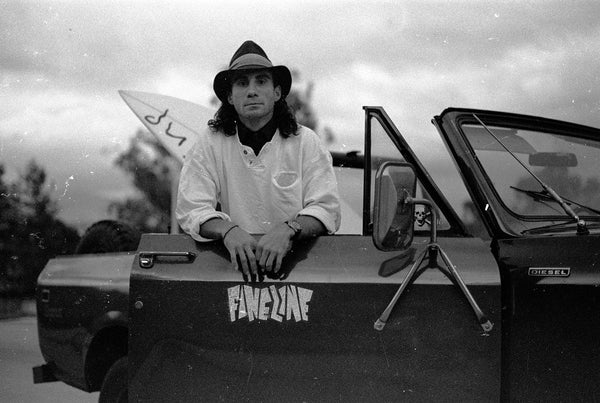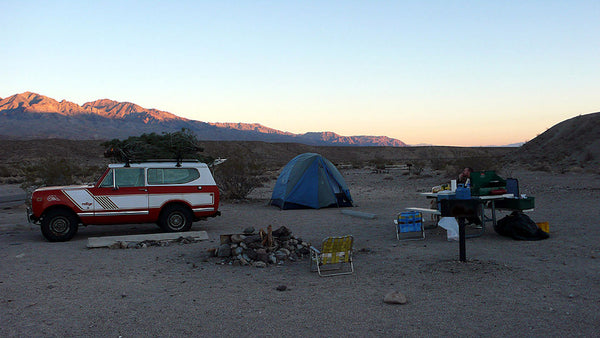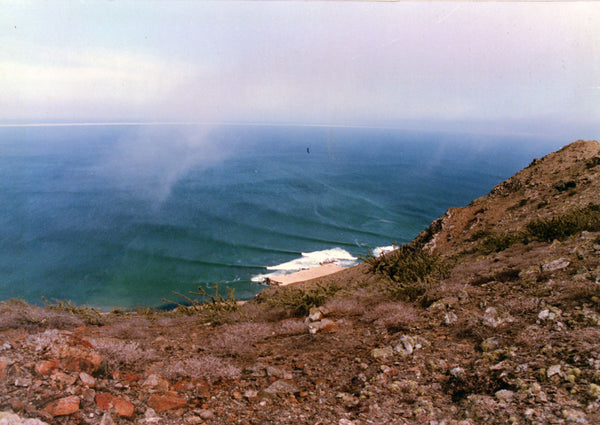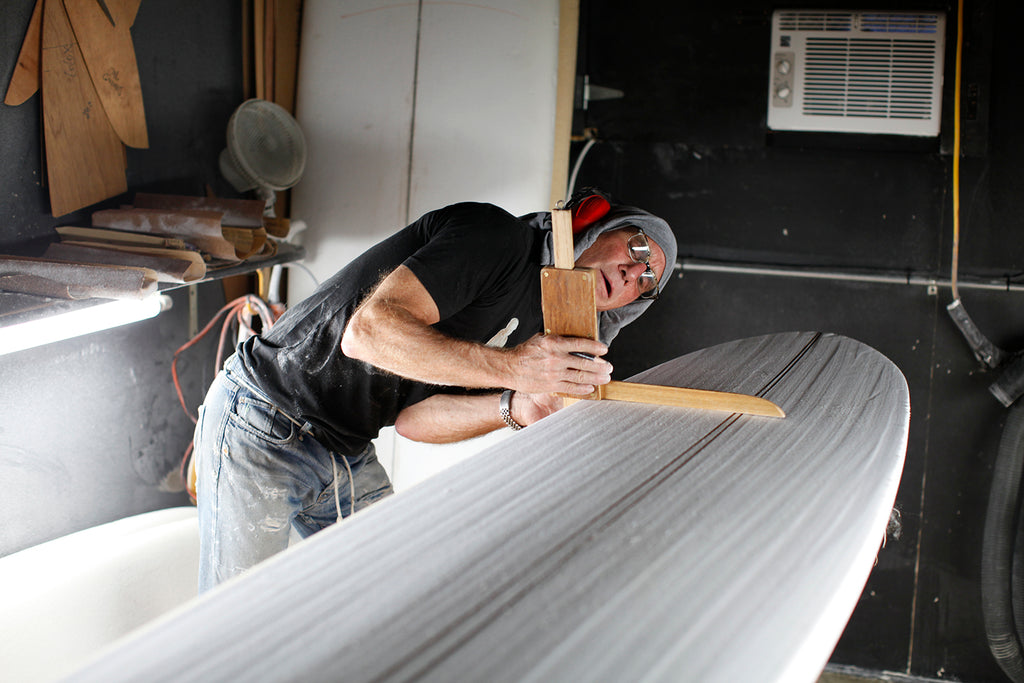Backyard Board Design With Fineline's Brian Hilbers

[“My favorite shot. Snowed out of the north Absarokas, I fled to the Wind River range. This is on the way to the Big Sandy opening. 2001.” – Brian Hilbers]
Walk into Brian Hilber’s shaping room in the backyard of his home in Canoga Park and you may notice the disco ball hanging above the bay. He likes a little music while he unapologetically hacks into a foam blank with a Skil 100, and though his speedy shuffle around the board may appear as improvisation, it’s a strictly fashioned dance performed and perfected over 30 years of experience.
The inside of Hilbers’ home is a surf alpinist’s dream, full of backpacks, camping slippers, and weather-proofed ponchos he’s sewn together from found materials. If you poke around, you may find a few surf relics, like a 1971 Nat Young shaped Weber Australia. The decor is all authentically 1950s, from the Kit Cat Clock to the original pastel pink and green kitchen appliances. In his backyard, he sits in the Adirondack chairs he designed and built and enjoys an occasional Tecate or two. Roaming around his oasis, it’s obvious Hilbers’ eye for design is saturated into everything he does.
Growing up with an outdoorsy family in California, Hilbers spent his summer vacations surfing Jalama and climbing America’s west coast desert mountains. He started hanging around with his older brother’s friends and would hitch rides to the beach, leading to his experimentation with board building. Now, Fineline’s following covers both coasts and international waters.
We stopped into Hilbers’ California home and work space back in July to learn about his self-taught shaping technique and his personal surf history.
Chelsea Burcz: Could you talk about your process in whole? From start to finish?
Brian Hilbers: I’ve got kind of a weird style because you are probably familiar with people cutting out the template first, I don’t. I do all my entire rockering and thickness distributing before I even cut out the template.
I’m a numbers shaper, I am not an eye shaper. Of course I use an eye, ok? But there’s no eye on the planet earth that can tell what the rocker is on a board by just looking at it. No eye ball on the earth can tell you the actual rates of curve, I could give you a ballpark guess, but the eye views curves relativistically. And what’s that relative to? A straight line.
It can all look pretty effortless and it can all seem like I shove out a blank without measuring at all, but it’s because I know the blank. I know exactly what I’m doing with the planer, how much I’m taking off, but what I’m actually thinking through are numbers: what my tail rocker is, what my nose rocker is, what my thickness distribution is. You got a blank and it’s a lot wider than the boards gonna be, and it’s domed. The hulls are also convex on the bottom. So if I was cutting that blank by eye, it’s going to look impossibly thin in certain places because it’s getting thinner and thinner on the outside edges.
Even if I’m doing something for the first time, you never pick up the planer until you have an idea of what the hell you are going to do. I’m not just going to do a happy widdle on something that does not have what I need to have in the right places. After that, of course, eye has a huge amount to do with it. If the numbers are wrong, I will know it just by looking at it.
You can watch a lot of people shape and you’ll notice that they are really fucking afraid of the planer. They’re afraid of that critter! They don’t want to take too much off, you’ll see them start to work on the bottom of a blank, and then with the shaping room lights the way they are, you’ll see all sorts of big jagged edges show up. Those edges, of course, are only 1/16th of an inch deep, the lighting is brutal. But the point is, when the planer is tilting this way or that way, the muscle memory knows exactly what the planer is doing. You put it on the foot, not on the shoe. The shoe is that adjustable thing that comes up, the cutter head is there, so if you lean on it you’re cutting. If you lean on the back, the only thing that you are going to cut is higher than the shoe. It’s your most accurate tool. It doesn’t care about different densities of the foam, cares very little about the stringer, which is a lot denser, of course, because it’s wood.
Everything gets less and less accurate after that. Around 3% of what I do on the board is with a SureForm. People like it because they feel safer with it. A SureForm, you press harder, it’s going to dig deeper, it’s a weight related tool, the planer is not. You’ve got to know what your angle is with the planer at all times and where the weight is on the plane.
I am basically 100% self taught. I never worked in a factory. I didn’t even hang out with any fellow shapers, I hung out with the Natural Progression crew in the early ‘80s a little when I lived in Malibu. I was shaping in a garage and I would actually have to pipe down an extension cord for electricity. It’s up above Paradise Cove, it’s called The Clubhouse. I had my glassing done down at Natural Progression and I started talking to some of those guys, and it was from them that Randy Carranza and Scott Anderson started Aquatech. I’m actually Greg Martz’s longest running customer. When he started Waterman’s Guild in 1984 I was there with him. Then I moved back to the Valley briefly and then I moved to Venice, and when I moved to Venice I was actually shaping out of Aquatech.

[“Night shaping in the Clubhouse.” – BH]

[“Kinda really says it all. 1983.” – BH]
When I was at Aquatech, there were a lot of things I liked about how Chris Cahill shaped. Little things that caught my eye in terms of how he was using the planer, he’s a knowledgeable guy. Scott’s a master with a planer. One of the things that I know Cahill picked up from me is, almost everybody goes in on a blank from the outside in, but there’s tons of times where I work from the inside out because you are taking the crap from the middle and pushing it out.

[“The Clubhouse. I shaped here from 1983 to 1986. This is Winding Way, right above Paradise Cove, north of PCH in northern Malibu. Actually, no power — I dropped a 10-gauge extension cord down from the upper garage to get power for my planer, compressor, and lights. I used a car cassette player and a car battery for tunes. Not enough amperage. The ranch house (not shown) was true Malibu adobe old school. These places all existed because Malibu had saturated its septic limit, based on the Coastal Commission. Most of this land was owned by guys like Bob Hope and Ronald Reagan, who just wanted to develop. They finally ramrodded a septic bill through the county — let’s thank Mike Antonovich — so that all of this land could be ‘properly developed.’ My landlord, and hence myself, got pitched in ’86 — I was ready to leave, anyway. Almost as important is the car in front: a 1973 Ford Pinto, at the time my only car — ‘Fluid Floyd the Sewer Snoid,’ or simply Floyd for short. Behind the garage there was a set of four 15″ Maverick (the same 4-lug pattern) wheels with Armstrong Norseman tires. With, or before them, without, Floyd clocked in almost 20,000 miles of Baja time, including many a trip to ‘4-wheel drive only’ locations, not to mention Great Slave lake for a climbing trip, and a helluva lot of ski trips. Like many of my cars, he never got sold — he was towed away by LA county from in front of my Malibu ghetto in 1986, after being convalescent for around a year. I’d bought Sherm.” – BH]

[“Me and Sherm, 1986. Neither of us quite so tattered as we are now — years AND mileage! Another 6-channel, 3-fin by now, in the back.” – BH]
CB: So you started making boards for yourself and it just continued. Have you ever had any other sort of occupation?
BH: You mean besides graduating from UCLA with an environmental biology degree? Well, I rather just shape surfboards. Needed the retail surf day job until around 1990, then I really didn’t need it anymore. I could pretty much make a living.
[Pulls foam blank down.] This is an Eric Arakawa, totally re-rockered. Of course, it’s certainly not the stock rocker. If you want a board to act different, it has to be different. Just in terms of it’s basic physics it has to be different to make it behave in a different way. This board is completely re-rockered, I’m actually going to completely tweak the thickness distribution and the rocker to be something different. I know what I want, it’s shaped in my head. Then I look at the blank and say, what can I get out of this? It’s a 7’6 blank, can I get a 7’6 out of it? No way in hell. I get 7’4s out of it. But that’s almost painful to watch, so I’m going to make this 7’2.
I use three different templates on every egg. I have a tail, I have a nose. Computers scale boards precisely. Let’s say you got a 7’6 x 21 ½ x 16 ¼ x 15 ¼ alright? Well, Mr. Computer will say at 7’4, it’s supposed to be 21 ¼ x 15 x 16. That ain’t the same board. To me, a model is actually defined by it’s nose and it’s tail and whatever the width is, if it forms with the templative curve at that time. So, in other words, every egg pretty much has a 15 ¼ tail or a 16 ¼ nose, unless I want it different. Sometimes the nose is a little bit narrower.
To me, full templates automatically limit what you are able to do. Full templates take away from your creativity because you can instantly tweak anything when you are putting a template on it. You can look at it and say, well that doesn’t look right to me.
CB: How long did it take you to arrive at this method?
BH: I almost started this way actually. The first thousand boards I shaped were not with a Skil 100, they were from a Sears Craftsman that had a fixed dial on the top, so I couldn’t do moving cuts. So I did rockers with what is basically integrated calculus, I made rectangles. I stepped it. Short, longer to longer on a given cut. And then just clean the whole thing.

[“Would you cut a Christmas tree and end up in Death Valley? I do, every year (almost, sometimes I end up in Tahoe). 2008, with Shane, Zero, and Jake, the ‘pretty’ Scout. Alongside Sherm, his first name was Fifi.” – BH]

[“Punta Abreojos, 1979, at the Asylum automatic lighthouse. An excellent contemporary lineup of boards: a six channel single, a McCopy single, a Shaun Tomson twin for Court Overin (17 years shy of being publisher of Surfer Magazine) — all around 6’1-6’2.” – BH]

[“Eric Perram warning me, ‘No Food or Drink in the Shop!’, fall 1980, northern Baja. Lots of thigh, all the boards well under 6’0, except Dave Letinsky’s, the far right 6-channel. Not shown was my first non-bonzer 3-fin, a real Thruster, that I took on this trip. I was impressed!” – BH]

[“A southern Baja point that took a 2-stage inflatable journey, with a mile portage in between. 1987. Now a surf camp.” – BH]

[“The water end of the portage route.” – BH]

[“Death Dealing Swedes, maybe my all-time favorite board. The break was named after her (the Swede). On the inland side of the portage route. The tattoo ribbon around the skull reads ‘Honor No Dead.’ Read it like a Jamaican, not an American. Yeah, another 6-channel.” – BH]
CB: What propelled you into shaping?
BH: I liked it, I just liked the whole idea of it. I basically made more and more of them. I think my second board was for somebody else. Poor guy.
My dad was an alpinist and a dedicated skier. My parents were full mountain people. My Mom was actually a Mormon, I think my great grandmother was the only person who ever told Brigham Young to go to hell four times and get away with it, and still stay a faithful Mormon.
We were water people, but I pretty much surfed on my own. What they did like to do is go to up to Jalama and take us with them. We had the full classic camper. My parents’ house is about a mile and a half away from mine. My dad still lives there, he’s 89. He’s a wine writer, a restaurant writer and a travel writer, so he just gets free loads left and right. Nice life.

[“In front of my parent’s house, around one mile away from where we drank a Tecate or two. Deep SFV.” – BH]
I have an older brother, he’s an artist. He got into surfing and the crew he was with got into surfing, they were all hanging out at San Fernando Valley State College, which is North Ridge now. Their art department was probably the best in the late sixties and early seventies in LA, including Arts Center and the rest of them. They had a couple of original Bauhaus guys there, I mean who went there and hung around there. Ken Jones who invented Thrasher magazine and Robert Williams was there; Craig Stecyk was a lurker. He never did the courses but he seemed to hang out there. A lot of those guys surfed and I was precocious so I tagged along. I was basically surfing way before I learned how to drive. My brother would drive me down to the beach and his buddies would take me when he couldn’t go. I did a lot of my surfing up at Jalama. Once my brother turned 21 he didn’t go on the family trips anymore and my parents would still go to Jalama, so I’d go with them and bring a board and just get pummeled — no leashes at that time! Everything, of course, was all shortboarding then.
CB: What were you riding then? Do you remember?
BH: Oh sure, I actually started on a Greg Liddle. During those formative years, I started making boards for myself. Because I knew how to fiberglass, I would go to a shaper that really interested me and would have them shape me a blank. So I’d buy a shaped blank and then I’d glass it myself, and then after getting the chops out of it I might copy it, I might not. Often I’d copy it for other people to whatever limited extent I could copy it. No one had the slightest clue about rocker or any of the other stuff then, it just sort of looked right. But actually, I was riding stuff shorter than just about everybody else. Right at that time is what I call “aloha madness” — it’s funny because shortboards were getting shorter and both here and in Australia, especially in Australia. The boards were being adapted to riding the kind of waves we were having.
Then Five Summer Stories came out and everyone saw Gerry Lopez ride Pipeline. And for three or four years, everyone was riding 7’2 to 7’8 guns, pintails, in three foot slop. I didn’t go there, I had 6’6s, 6’4s just stuff that was just a little bit shorter. In fact, looking through surfing magazines I was totally inspired because the east coasters never fell into that flaw. Guys like Claude Codgen — I can remember seeing boards and ads for Claude Codgen. In fact, I still have this one 6’4 in my parents’ rafters that I basically created a template for just from eyeball, literally nothing was looking like that locally.

[“That’s Michael Peterson with THE board — the board that did ‘the Cutback’ in Morning of the Earth. I based the MP on this board.” – BH]
There were some very good shapers here in the valley; Greg Liddle was here. Ernie Tanaka in North Hollywood in Van Nuys, excellent shaper. And then Jeff Ho was doing some very interesting stuff. That was one of the shaped blanks I got. I actually went into the Jeff Ho showroom at Bay Street and saw Ronnie Jay, who became a good friend later. I said, ‘I want a 6’6’ and he said, ‘No way you gotta get a 7’0.’ So I got a 7’0. It was pretty funny because when I picked up the shaped blank it had this classic Craig Stecyk airbrush on the bottom, these weird little clouds. And then Skip Engblom told me to make sure I sanded it and kept the edges in it, that the edges were really important. That was the triumvirate back then: Jeff Ho, Skip Engblom, Craig Stecyk. And then the Jeff Ho surfboards turned into Zephyr surfboards, and then the skateboards — it went on from there.
CB: So why the fifties? Why is that your style of choice?
BH: You know it would be my style of choice anyway because it was about the last time people looked at stuff with newness. Like Swan Optics Beacon Hills, real ones. Got them new old stock. When did people start using glasses and make a style like this? They did it then. Through the ‘60s people did new style. After that, new style sort of stopped. Now they are derivative of something else. People thought things through, it was for the people.
Shop Fineline surfboards here or order a custom with us!
– words by Chelsea Burcz











